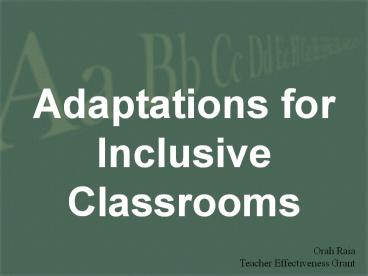Adaptations for Inclusive Classrooms - PowerPoint PPT Presentation
1 / 15
Title:
Adaptations for Inclusive Classrooms
Description:
Title: PowerPoint Presentation Author: Orah Raia Last modified by: TCNJ Created Date: 2/19/2004 1:36:26 PM Document presentation format: On-screen Show – PowerPoint PPT presentation
Number of Views:160
Avg rating:3.0/5.0
Title: Adaptations for Inclusive Classrooms
1
Adaptations for Inclusive Classrooms
Orah Raia Teacher Effectiveness Grant
2
All students can learn and succeed, but not all
in the same day in the same way. William G.
Spady
3
What is the difference between accommodations
and adaptations ?
4
Accommodations
- Accommodations are used to refer to changes that
are stipulated in an individual students IEP in
order to enable the student to gain access to the
classroom or the curriculum. - Examples
- allowing extra time on a test
- providing the student with a quiet area
- allowing the student to sit close to the board
From Janney, R. Snell, M.E. (2000). Modifying
schoolwork. Baltimore, MD Paul H. Brookes
Publishing Co.
5
Adaptations
- Adaptations are changes to the requirements of
the learning task, often temporary or reduced
over time. - Examples
- Curricular- what is taught
- Instructional- how it is taught or assessed
- Ecological- where, when or with whom it is taught
From Janney, R. Snell, M.E. (2000). Modifying
schoolwork. Baltimore, MD Paul H. Brookes
Publishing Co.
6
Curriculum Adaptations
- 1. As is - Students are involved in the same
lesson as other students with the same objectives
and using the same materials. - 2. Providing physical assistance - assisting a
student to complete activities by the actual
manipulation of materials , equipment or his/her
body. - 3. Adapting materials - Utilizing materials that
allow for participation in age-appropriate
activities without having pre-requisite basic
motor, communicative or cognitive skills.
7
Curriculum Adaptations
- 4. Multi-Level Curriculum - Students are working
in the same subject area, but are working at
different levels of curriculum. - 5. Curriculum Overlapping - Students are involved
in the same activity with other students but may
have a goal from a different curriculum area. - 6. Substitute Curriculum - Students are involved
in alternative activities that meet primary
instructional needs when the general education
curriculum at that time does not. This is
determined by the student planning team. Priority
is given to involvement with peers at alternative
activities. - Reprinted from Neary, T., Halvorsen, A.,
Kronberg, R., Kelly, D., Curriculum Adaptation
for Inclusive Classrooms, California Research
Institute, San Francisco State University, San
Francisco, CA. (1992).
8
Partial Participation
- This principle suggests that individuals who have
disabilities should not be deprived of
opportunities to participate in typical school
and community activities. A student may not be
able to do every part of an activity but that
does not mean some level of participation would
not be meaningful to that student.
9
(No Transcript)
10
Strategies for adaptations for this lesson
- Provide structure and consistency
- Present content in small segments
- Vary the reading level
- Pre-teach any new vocabulary
- Use visual presentations
- Engage students in active learning
- Use concept maps
- Provide alternative methods to record and assess.
e.g., giving verbal reports or drawing pictures
v.written report - Let students use a computer for writing, e.g., a
laptop or AlphaSmart - Use an FM system for student with hearing
impairment - Assign leadership roles to the students whom have
ADD
11
The Bear and Two Travelers by Aesop
12
The Bear and Two Travelers, A Fable by Aesop
Using Kidspiration
13
Concept Map for Fables Using Kidspiration
14
Activity using Inspiration software
15
The outside doesnt necessarily represent what is
on the inside































